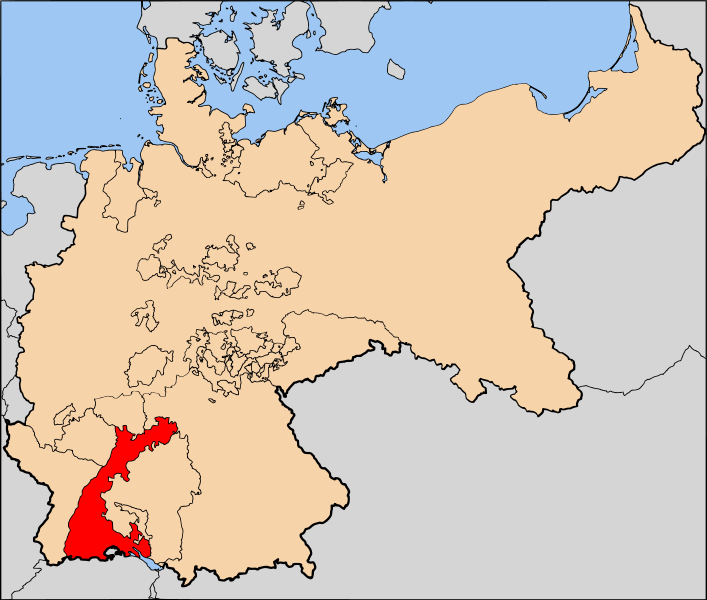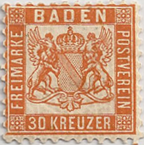ALBUM – view my Grand Duchy of Baden Album
Fast Facts
Region: Germany / Poland Area
Group: German States
Classification: Semi-autonomous State
Prior Regime: A state of the Holy Roman Empire
Key Dates:
1806 – Baden raised to the status of a Grand Duchy
1815 – Baden joined the German Confederation
1849 – Became a Republic for a short time during the German States revolutions
1866, Aug 17 – The Grand Duchy of Baden leave the German Confederation, allying with Prussia.
1871, Dec 1 – Became a founding member of the German Empire
Following Regime: Empire of Germany
Scott Catalogue: (German States, Baden) #1-28, LJ1-LJ3
Pick Catalogue: (Germany, Badische Bank, Bank of Baden) # s901-s902 before German Empire, s903-914 until
Currency: 60 Kreuzers = 1 Gulden
History

In 1806, Baden, ruled by Charles Frederick, aided France in the final destruction of the Holy Roman Empire, and as a result was elevated to Grand Duchy and became a part of Napoleon’s Confederation of the Rhine. In 1811, Charles Frederick died and was succeeded by his grandson, Charles, who was married to Napoleon’s adopted daughter.
Charles fought for Napoleon until 1813, when he switched allegiance after France was decisively defeated at the Battle of Leipzig. After Napoleon was ultimately brought to his knees at Waterloo in 1815, the German speaking world was left fractured into two major powerhouses, Austria and Prussia, and a multitude of smaller Kingdoms, Duchies, Principalities and Free Cities. To attempt to stave off additional wars, the Congress of Vienna, in 1815, created the German Confederation. The Confederation, initially consisting of 39 German states including Baden. The Confederation was a loose political and military alliance, and although it was officially led by Austria, it was essentially meant to create a buffer between Prussia and Austria.
Beginning in France in Feb, 1848, revolution spread across much of Europe and over to Latin America. People began demanding an end to the old feudal systems, demanding democratic changes such as freedom of the press and of assembly. The revolt spread to Baden, forcing Grand Duke Leopold to flee the country. Eventually, with Prussian military intervention, order was restored in Baden and the Grand Duke returned in Aug. 1849, but Europe would never be the same.
Between 1850 and 1866, Baden was a consistent supporter of Austria; and in the Austro-Prussian War of 1866, faced Prussian troops. However, Grand Duke Fredrick was forced by his cabinet to end the war and enter into an alliance with Prussia. When Prussia won the war, they annexed territory and began the process of establishing a unified Germany.
This major power shift angered the French which ultimately resulted in the Franco-Prussian war of 1870/1871. The Prussian / German alliance overwhelmed the French, and on Jan 18, 1871 during the Siege of Paris, proclaimed Wilhelm as the German Emperor in the Hall of Mirrors at the Palace of Versailles. Duke Fredrick of Baden himself was at the assembly in Versailles and was the first to commit allegiance to the new Emperor.

Stamps
 ALBUM
ALBUM
On 1 May, 1851, Baden joined the German-Austrian Postal Union and on the same day issued its first definitive stamps (1, 3, 5 and 9 Kreuzers). The stamps were imperforated, designed in the same model as Bavaria containing the denomination in a circle and inscribed “Baden” and “Freimarke” (definitive stamp).
Beginning in 1860, Baden issued perforated stamps, featuring the Coat of Arms of the Grand Duchy. Various denominations, colors and perforations over the various different printings.
In addition to the definitives, “Landpost” stamps were issued in three values of 1, 3, and 12 Kreuzer on 1 Oct, 1862. The purpose of these stamps were to collect an additional charge for delivery to rural villages not served by a local post office. While the sender could pre-pay the charge, the Landpost stamps could also be used as a Postage Due for those receiving mail in those villages. It was normally placed on the reverse of the envelope.
On 31 Dec, 1871 the entire postal system of Baden changed hands to the German Reichspost. Baden’s stamps could only be used until the end of 1871, but Baden stamps could be exchanged for stamps of the German Reich until February 25, 1872.
Banknotes
In 1870-71, the Grand Duchy of Baden issued two banknotes- 10, 50 gulden. After, joining the German Empire, Baden, as did a few other former Duchies, continued to issue banknotes in Marks. This practice continued through World War 1, and into the inflation period which followed. The last banknotes for Baden were issued in 1923, and they fully converted to German currancy with the revaluation later that year.
Links
Grand Duchy of Baden from Wikipedia
Grand Duchy of Baden History and Monarchs
Wikipedia Postage stamps and postal history of Baden
Stamp Collecting World – Grand Duchy of Baden
German States Banknotes




